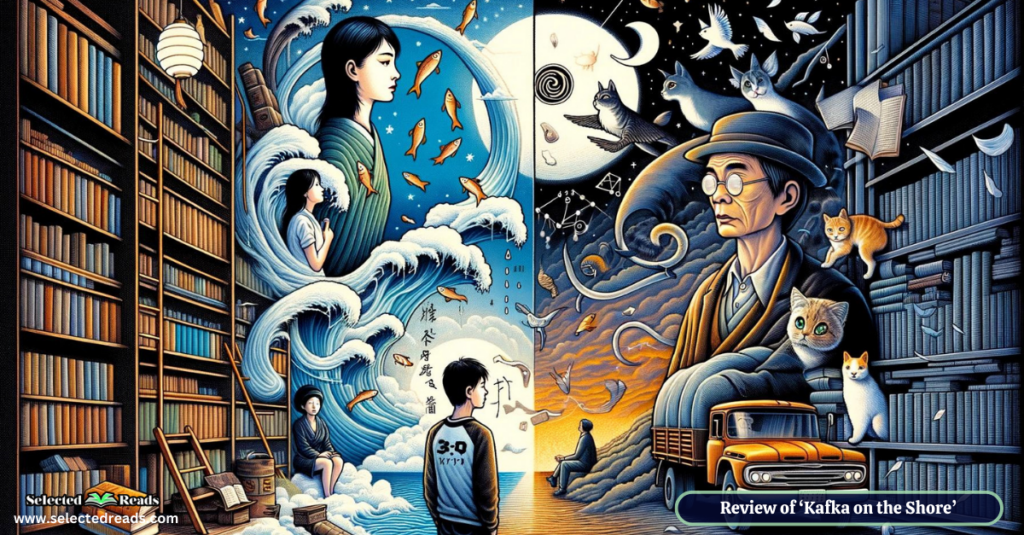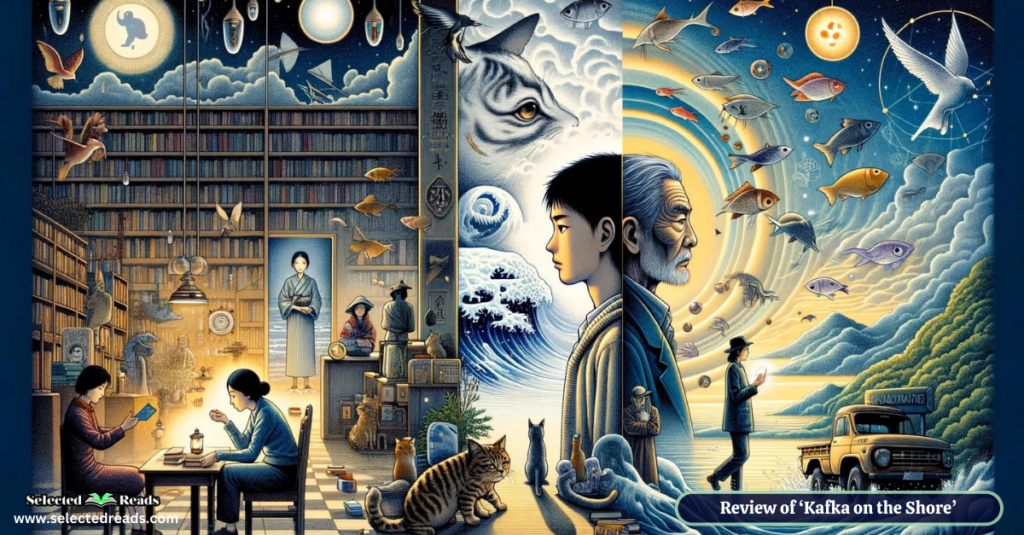“Kafka on the Shore” by Haruki Murakami is the focus of our post today. This novel, a masterpiece that elegantly dances along the edges of magical realism and contemporary fiction, entices readers into a world where the boundary between the metaphysical and the mundane is blurred. The purpose of this post is to familiarize you with the essence of this enigmatic story without spoiling the myriad of surprises that Murakami has ingeniously woven into its fabric.
My discussion will proceed as follows: First, I provide a summary of the novel, highlighting its main plot points and the unique blend of reality with elements of fantasy that characterizes Murakami’s work. Next, I discuss characters, delving into the depth and complexity of Kafka Tamura, Satoru Nakata, and the other pivotal figures whose journeys across the shores of consciousness and reality define the narrative’s heart. To wrap up, I’ll offer some thought-provoking book club questions designed to inspire deeper reflection and debate on the themes, motifs, and unforgettable moments that make “Kafka on the Shore” a truly remarkable journey.
Kafka on The Shore Summary
“Kafka on the Shore,” by the eminent Haruki Murakami,centers around two characters, each on a journey that is as much internal as it is through the physical world. Kafka Tamura, a 15-year-old with a heavy heart and a mind full of turmoil, decides to run away from his Tokyo home to escape a cursed Oedipal prophecy and the shadows of a dysfunctional family.
His journey is not just a physical escape but also a quest for identity, belonging, and understanding. Kafka finds refuge in a private library in Takamatsu, where he seeks solace in books and forms connections with a mysterious woman named Miss Saeki, who has her own spectral past, and Oshima, a resourceful librarian who becomes Kafka’s guide through his trials.
Photo: Amazon
Parallel to Kafka’s story is that of Satoru Nakata, an aging and simple-minded man who never recovered from a strange affliction in his childhood that left him with the ability to communicate with cats but robbed him of his memories and conventional intelligence.
Nakata’s life is upturned when he finds himself involved in a series of events that propel him on a path that intersects with Kafka’s in unforeseeable ways. Accompanied by a truck driver named Hoshino, Nakata embarks on a mission that involves searching for a mystical stone and confronting forces beyond human understanding.
Murakami crafts a world where the fantastical elements—talking cats, fish raining from the sky, spirits embarking on ethereal escapades—serve as metaphors for the characters’ inner lives and struggles. The narrative oscillates between the two protagonists, slowly unraveling the connections between them and exploring themes of fate, consciousness, and the nature of reality.
As Kafka delves deeper into the mystery surrounding Miss Saeki and the secret history of the library, he confronts his darkest fears and desires. Meanwhile, Nakata’s quest brings him face to face with a malevolent force that challenges his understanding of his role in the world.
Kafka on The Shore Characters
Here is a quick run-down of the characters in ‘Kafka on The Shore’:
- Kafka Tamura, The Adolescent Runaway: A 15-year-old boy on the run from his Tokyo home, Kafka seeks to evade a dark familial curse and find his own identity. Intelligent, introspective, and burdened with complex emotions, his journey is a quest for understanding, belonging, and connection. Kafka’s path leads him to a quiet library in Takamatsu, where he finds solace in literature and forms deep connections with the enigmatic Miss Saeki and the resourceful librarian, Oshima.
- Satoru Nakata, The Simple-minded Elder with a Gift: After an unexplained incident in his childhood, Nakata emerged with no memory and an inability to read or write but with the extraordinary ability to communicate with cats. His life takes a turn from the mundane to the mythic as he becomes entangled in events that are both fantastical and sinister. Nakata’s journey, marked by his simple nature and profound supernatural connection, eventually intersects with Kafka’s, weaving together themes of fate, identity, and the metaphysical.
- Miss Saeki, The Mysterious Librarian with a Past: Once a beautiful, talented young woman, Miss Saeki is now a shadow of her former self, managing a private library in Takamatsu. She harbors a deep connection to a tragic love story and a haunting past that is intricately linked to the library’s secrets. Miss Saeki becomes a central figure in Kafka’s story, embodying themes of memory, loss, and unattainable love.
- Oshima, The Resourceful Librarian: Oshima is a young, intelligent, and enigmatic librarian who works alongside Miss Saeki. He becomes Kafka’s guide and protector, helping him navigate the complexities of his quest and the challenges he faces within and outside the library. Oshima’s own secrets and insights add depth to the narrative, offering perspectives on gender, identity, and the nature of human connection.
- Hoshino, The Laid-back Truck Driver: A truck driver who becomes entangled in Nakata’s quest, Hoshino is drawn into a world far beyond the ordinary. His transformation from an indifferent bystander to a crucial player in the unfolding mystical events highlights themes of change, responsibility, and the impact of chance encounters on one’s life path.
Kafka on The Shore Book Club Questions
Here’s a list of questions that can stimulate interesting conversations:
- Themes and Symbolism:
- How do the themes of fate and destiny play out through the characters of Kafka and Nakata? Do you believe they have control over their destinies, or are they merely puppets of fate?
- Murakami often uses surreal elements (e.g., talking cats, fish raining from the sky). How do these elements enhance or complicate your understanding of the story’s themes?
- Explore the significance of the “entrance stone.” What does it symbolize, and how does its presence affect the narrative and the characters?
- Character Analysis:
- Discuss the transformation of Kafka Tamura throughout the novel. What are the key moments that define his character development?
- Nakata’s character offers a stark contrast to Kafka. In what ways does Nakata’s simplicity and his supernatural abilities provide insight into the story’s deeper meanings?
- Miss Saeki is a pivotal character with a mysterious past. How does her history intertwine with Kafka’s journey, and what does she represent to him?
- Motifs and Interpretations:
- Music, especially classical music, plays a significant role in the novel. Discuss how Murakami uses music as a motif and what it contributes to the overall narrative.
- Dreams and the subconscious are recurring elements. How do these aspects influence the characters’ realities, and what do they reveal about their inner lives?
- The concept of duality (light vs. dark, reality vs. fantasy) is prevalent throughout the book. Identify instances of duality and discuss how they contribute to the novel’s message.
- Literary and Narrative Structure:
- Murakami’s narrative structure interweaves two seemingly separate stories. How did this structure affect your reading experience, and how do you interpret the connection between Kafka’s and Nakata’s stories?
- The novel contains many references to Western literature and philosophy. Discuss how these references enhance the depth of the story and its themes.
- “Kafka on the Shore” leaves many questions unanswered. Do you find this open-endedness satisfying or frustrating? How does it impact your interpretation of the novel’s conclusion?
- Personal Reflection:
- Which character did you find most compelling, and why?
- Were there any parts of the book that you found particularly challenging or confusing? How did you reconcile these moments in your understanding of the story?
- Has this book changed or affected your perspective on fate, consciousness, or the nature of reality? If so, how?
Final thoughts
To conclude, I hope that you have found this short review of “Kafka on the Shore” interesting. Haruki Murakami’s “Kafka on the Shore” is a mesmerizing blend of the surreal with the deeply human, a novel that defies easy categorization. Its rich narrative, complex characters, and profound themes offer a reading experience that is both intellectually stimulating and emotionally resonant. If you have not already ventured into the enigmatic world Murakami creates in this novel, I highly recommend doing so.









